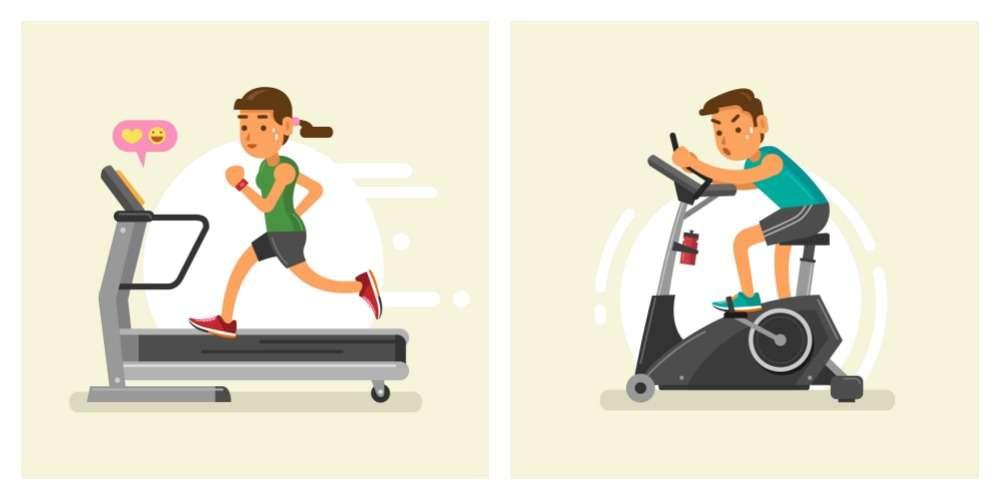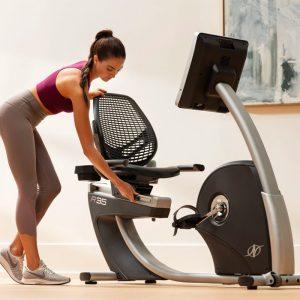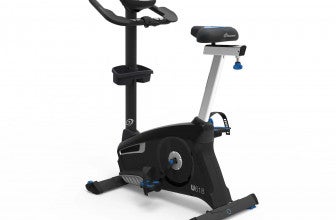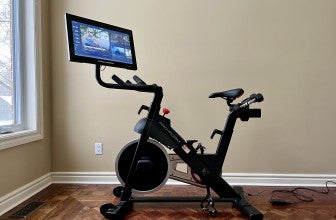As you go about choosing a piece of cardio equipment to use to complete your workout program, it’s essential that you are selecting properly for your needs, goals, and preferences.
Not all cardio equipment is created alike. Each offers its own benefits and drawbacks so understanding these will guide you down the right path. When looking at the stationary bike vs. treadmill, there are some marked differences to know about.
The treadmill burns loads of calories, provides intense workouts, but puts you at a high risk of injury in many cases. The stationary bike doesn’t burn as many calories, but provides greater strengthening benefits and sustains a lower injury risk factor.
So which should you choose? Let’s help you make the right decision.
The Stationary Bike Vs. Treadmill – Defined
| Pros | Cons | |
| Treadmill |
· Burns a high number of calories when running or walking on a step incline · Is something that just about everyone can comfortably do · Offers variations of speed and incline |
· Has a relatively high injury risk of knee or back pain, especially when jogging
· People may ‘cheat’ and hold onto the handle bars to make the exercise easier · Incline function may break down often · Is high impact so harder on the joints · There is a fall risk associated with this machine · Requires ongoing maintenance |
| Stationary Bike | · Lower total risk of injury (it’s not completely risk free, but your overall injury risk is much lower)
· Is something that most people can easily do · Strengthens the lower body muscles · May help to build strength if a high enough resistance is utilized · Is non-impact |
· Doesn’t burn quite as many calories
· The upper body isn’t involved at all in the exercise · Butt pain may result from sitting in the seat so long
|
When looking at the stationary bike vs. the treadmill, there are a number of factors to consider.
Calorie Burn
First think about the calorie burn. In order to lose body weight, you need to burn more calories than you consume. So any exercise that has you burning plenty of calories is going to be great for helping assist with the weight loss process. The more calories you can burn in a given time frame, the more beneficial that exercise is.
Here, the treadmill wins out. Provided you are jogging or walking at a higher incline using a brisk pace, you can burn up to 600 or even 700 calories per hour in some cases. This lends very well to creating the deficit needed for fat loss.
With the bike, if you are going at quite an intense rate, you can expect to burn around 400 calories per hour, maybe 500 calories if you really push yourself to the limit.
Cost
As a rule, treadmills tend to cost more than exercise bikes and require more care. Both machines will require maintenance, but treadmills will need their belts lubricated with some frequency. As with any equipment, prices vary greatly. Prices for top units range from under $1,000 to more than $3,000 based on our review here. Bikes on the other hand tend to be under $2,000.
Consider top-rated treadmill the Sole F80, priced online at $2,799, which comes with a 3.5 CHP motor and 15% incline. Or, one could opt for the top-rated exercise bike ProForm Studio Bike Pro 22 which retails online for $1,299 and brings 24 levels of resistance. With bigger machines come bigger costs, and that tends to be the case with treadmills versus bikes. That said, there are more options with treadmills when it comes to workout programming, and again, that factors into price. The NordicTrack Commercial X22i treadmill and the NordicTrack Commercial S15i Studio Cycle also bear this out with respective pricing of $2,999 and $1,599. Both units feature automatic trainer control and the iFit Coach workout app, with the treadmill sporting a 22″ HD Smart Touchscreen and the cycle a 14″ HD Smart Touchscreen.
Injury Rate
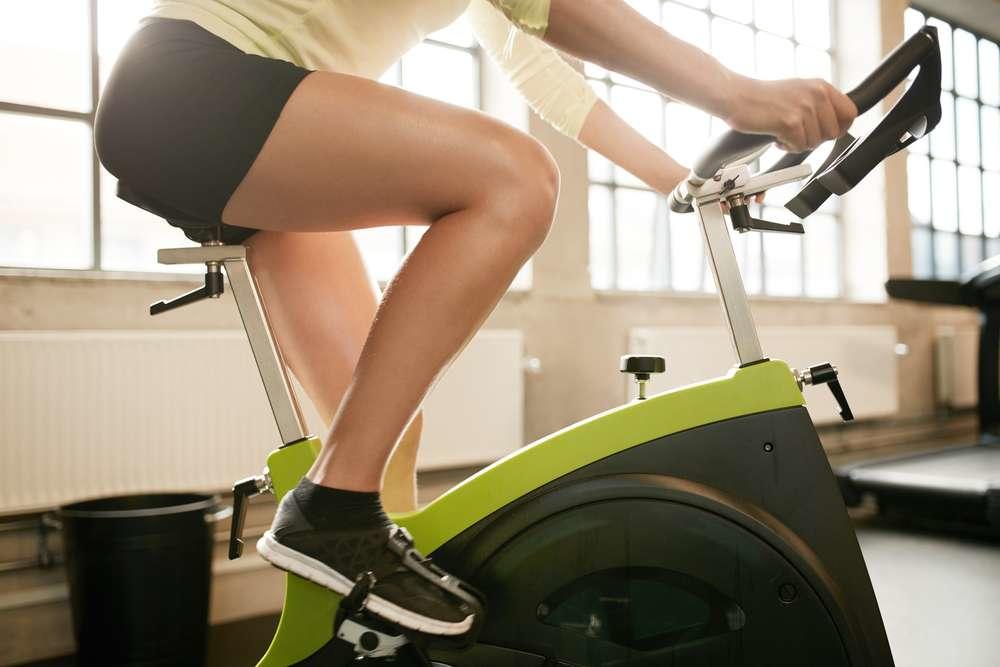
Not only is the treadmill high impact, it also comes with the chance that you could loose your balance and fall off the machine. Or, if you stepped on your foot funny, it could lead to a sprained ankle, which could take you out for weeks, if not months depending on the severity.
With the bike, these injury risks just don’t exist. The three primary injury risks you’ll face on an exercise bike are:
- Butt pain from sitting on the seat for so long (which could be overcome with padded undergarments)
- Knee pain from constant circular rotations made with the legs
- Back or shoulder pain from being hunched over for so long
All in all, this list is quite short and generally very manageable if you take the right approach. Ensuring sufficient days off during the week will help to minimize the chances of sore knees and using good posture while you bike and considering a massage for your neck and shoulders are both very wise to help minimize pain and discomfort.
The treadmill injuries are simply more severe and less avoidable, so if injuries are a concern, this would likely lead you to choose the bike over the treadmill most of the time.
Workout Variability/Progression
An important element of seeing continual progression with your workouts is constant variability. Basically, you need to change something around with the workout regularly. Otherwise the body adapts and soon, it stops responding entirely. Instead, you just maintain the status quo.
So which machine offers the best variability? Stationary bike Vs. treadmill?
It’s an even playing field. With the bike, you can increase the speed you ride at or you can increase the total amount of resistance that you use.
With the treadmill, you can also increase the speed at which you ride at, but in addition to that, you can also increase the incline. This allows you to go from walking (or jogging) on flat ground to doing so on a hill (incline).
Both are great ways to boost the intensity of the program and give you good results.
Ease Of Use

The bike is usually just a hop on and go type of machine, so there’s no learning curve here. Both are very user friendly so are great for beginner all the way to advanced trainees.
Machine Durability
When looking at which machine has the potential to break down more often, the stationary bike vs. treadmill, the treadmill comes out as more likely. There’s typically more than can go wrong with the belt, motor, and ability to incline than there is with the bike machine.
Stationary bikes rarely ever break down, so it’s uncommon to need servicing. As this will add to the total cost of the machine, this may be something that you really do need to consider.
Space/Footprint
Finally, if you look at the space or ‘foot print’ of the machine, we see that the bike is the clear winner here. It just takes up less room than a treadmill does, so if you’re exercising in a tight space, you’ll probably find that the bike is a more suitable choice for you.
This said, do keep in mind if you get a folding treadmill, it’s only going to take up space when unfolded, so that may be an option to overcome this problem.
Conclusion
So in the question of stationary bike vs. treadmill, we lean slightly more towards the stationary bike due to it’s ease of use, reduced risk of injury, and greater machine durability.
But, if maximum fat loss is your goal and you feel you can be careful to avoid injury, then the treadmill may be your better choice. Spend some time thinking about what’s most important to you and then make an informed decision from there.
Photo credit: 4 PM production/Shutterstock; konggraphic/Shutterstock; Jacob Lund/Shutterstock
